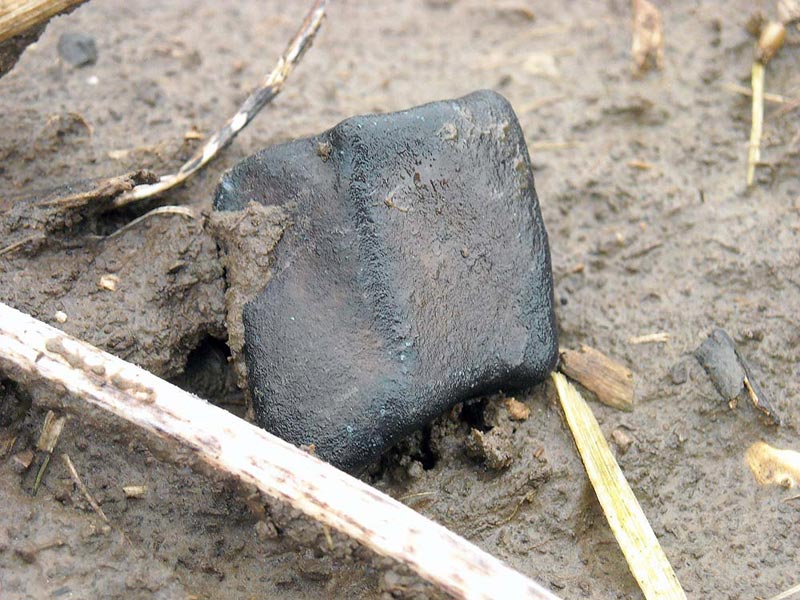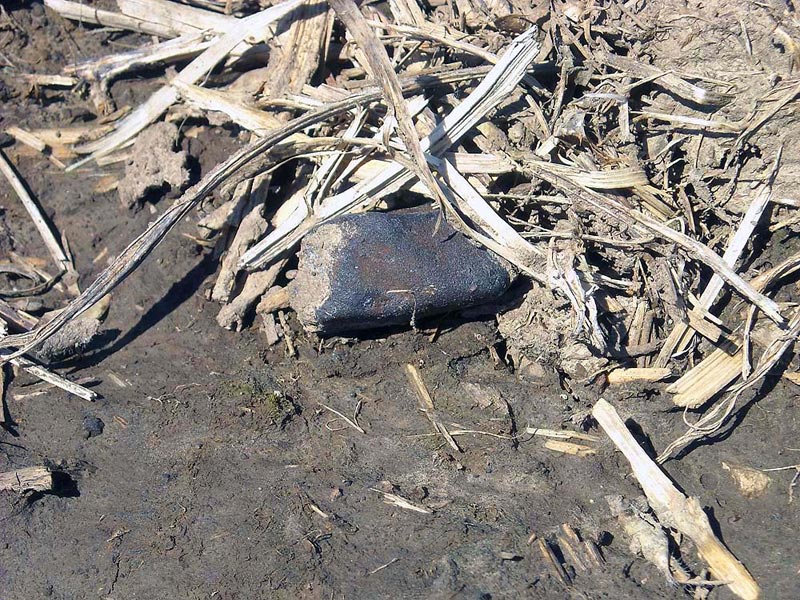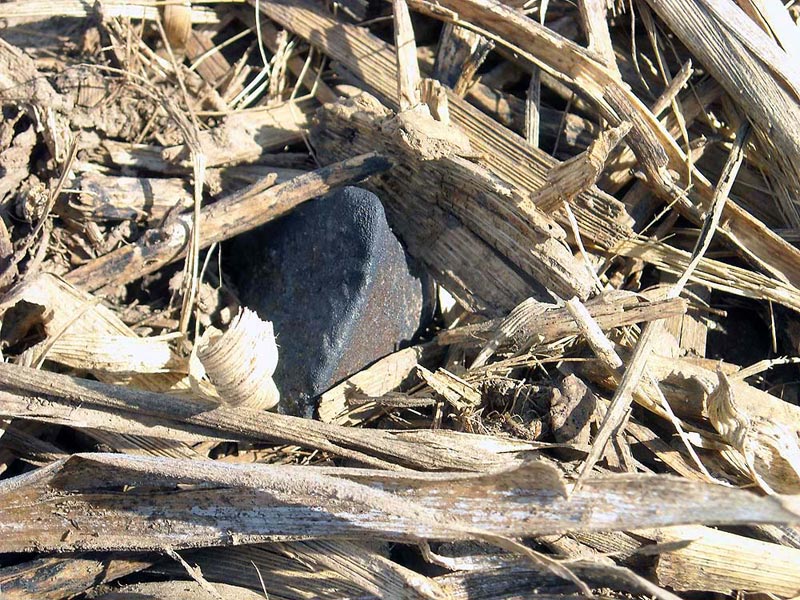Mifflin Meteorite Strewnfield Map
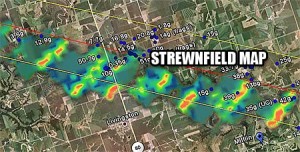 This article was written by Eric Wichman. Any modifications made by SkyFall Meteorites were only for clarity and grammar. You can view photos of Eric Wichman’s meteoriteWork in progress. A solid natural object reaching a planet’s surface from interplanetary space. Solid portion of a meteoroid that survives its fall to Earth, or some other body. Meteorites are classified as stony meteorites, iron meteorites, and stony-iron meteorites. These groups are further divided according to their mineralogy and Click on Term to Read More finds at the bottom of this article, and also read the article he wrote on “The Great WI Meteorite Fall & Strewnfield” in the July issue of Meteorite Hunting & Collecting Magazine.
This article was written by Eric Wichman. Any modifications made by SkyFall Meteorites were only for clarity and grammar. You can view photos of Eric Wichman’s meteoriteWork in progress. A solid natural object reaching a planet’s surface from interplanetary space. Solid portion of a meteoroid that survives its fall to Earth, or some other body. Meteorites are classified as stony meteorites, iron meteorites, and stony-iron meteorites. These groups are further divided according to their mineralogy and Click on Term to Read More finds at the bottom of this article, and also read the article he wrote on “The Great WI Meteorite Fall & Strewnfield” in the July issue of Meteorite Hunting & Collecting Magazine.
After much work and the combined efforts of countless meteorite hunters, collectors, dealers and scientist’s data. The Mifflin, Wisconsin meteorite strewnfield map is done.
Disclaimer: Don’t use these maps to hunt meteorites! These maps are for educational and informational purposes only. If you use these maps for hunting meteorites, you do so at your own risk. Do not hunt on landowners land without gaining permission to hunt FIRST!
Mifflin Meteorite

Official Name: Mifflin
Observed fallMeteorite seen to fall. Such meteorites are usually collected soon after falling and are not affected by terrestrial weathering (Weathering = 0). Beginning in 2014 (date needs confirmation), the NomComm adopted the use of the terms "probable fall" and "confirmed fall" to provide better insight into the meteorite's history. If Click on Term to Read More: Yes
Fell: April 14, 2010, 10:07 pm CDT (UT-5)
Mass: (TKW) 3.58 kg
Mifflin: 42 °54’27″N, 90 °21’56″W
Iowa County, Wisconsin, United States
Classification: Ordinary chondriteWork in Progress Ordinary chondrites (OCs) are the largest meteorite clan, comprising approximately 87% of the global collection and 78% of all falls (Meteoritical Society database 2018)1. Meteorites & the Early Solar System: page 581 section 6.1 OC of type 5 or 6 with an apparent shock stage of S1, Click on Term to Read More (L5)
Mass (g): >3584
Pieces: >70
Class: L5
Shock stageA petrographic assessment, using features observed in minerals grains, of the degree to which a meteorite has undergone shock metamorphism. The highest stage observed in 25% of the indicator grains is used to determine the stage. Also called "shock level". Click on Term to Read More: S1
Weathering grade: W0
SOURCE: Meteoritical Bulletin Meteorite Database
Thanks go out to all those who contributed data to help in the creation of this map. As far as I know there is no other Wisconsin meteorite fall strewnfield map which is more accurate with more coordinate locations that is publicly available.
All locations are accurate to within 10-20 feet of actual findMeteorite not seen to fall, but recovered at some later date. For example, many finds from Antarctica fell 10,000 to 700,000 years ago. Click on Term to Read More location. The variance is only due to the accuracy of the GPS device which recorded the data. If you happen to find an error or omission please let me know and I’ll get it fixed when I have time.
The distribution of the meteorites within the marked area suggest there are much larger pieces further southeast of MineralInorganic substance that is (1) naturally occurring (but does not have a biologic or man-made origin) and formed by physical (not biological) forces with a (2) defined chemical composition of limited variation, has a (3) distinctive set of of physical properties including being a solid, and has a (4) homogeneous Click on Term to Read More Point where the last 105.1g stone was found by Michael Cottingham. The 1.5g stone furthest to the northwest was found by a local meteorite hunter/landowner.
The path of the fireballA fireball is another term for a very bright meteor, generally brighter than magnitude -4, which is about the same magnitude of the planet Venus as seen in the morning or evening sky. A bolide is a special type of fireball which explodes in a bright terminal flash at its end, often with visible fragmentation. Click on Term to Read More took it over Preston, WI, Past Mifflin, and out further beyond Mineral Point dropping meteorites along the way.
Size of the WI Strewnfield
Video analysis of the fireball recorded from Milwaukee suggests the last two bursts or “fragmentation events” happened over Mineral Point, and eyewitness accounts have also supported this, meaning that much larger pieces of the WI meteorite can most likely be found further southeast of Mineral point. It’s possible the known strewnfield, as depicted in these maps, only account for HALF of the actual distribution ellipse. Given the very shallow 11 degree angle of descent, it’s been estimated by experts to be up to 25 miles long, perhaps longer.
Current known size is 16.37 miles long from the smallest to largest piece, and approximately 2.1 miles in width. There are two main clusters of meteorites distributed around the Iowa-Grant school, and the area near where the “Shed Hitter” was discoverd by a local landowner.
Dynamics of the Meteorite Finds & Meteorite Hunt
The meteorite hunt started near the “Shed Hitter” meteorite and continued outward from there logically expanding to surrounding properties for the first few days after the meteorite fall. It is this authors opinion that the reason there are two “clusters” of meteorites evidenced on the map isn’t only the effect of the fragmentation events in the video, but also the dynamics of the hunt itself and the publicity it generated in the media.
There was a media interview at the Iowa-Grant School a few days after the meteorite fall when a student found a meteorite practically on camera. Word got out quickly that a child had found a stone, at the school and meteorite hunters rushed to the school skipping much of the area between. Things happened fast after that and the areas between the school and where the Shed Hitter stone was found did not get hunted as hard during the following days and weeks. This is only my personal observation, and I could be wrong, but I’ll go with it…
It was tough hunting and nothing like the West, TX (Ash Creek) meteorite hunt. People complained “West” was hard to hunt. West was a cake walk compared to the Wisconsin meteorite hunt in the total hours hunted per meteorite found and miles walked to find them. It was grueling, painful and worth every aching and adventurous step. Meteorite Hunters went home with blisters on top of blisters. Most never found a stone in all their days of hunting. All of it was worth it though for the excitement of finding a fresh WI meteorite!
The Big Ones, Rumors & Misinformation
So where are the big ones? There were rumors circulating of a 2 kilo meteorite found by a local in the area. There are two reasons for this. I believe the first is because there was a local man traveling the area with a REAL meteorite, from a FRESH fall and it was a big one. My hunting partner and I caught up with this local at the Friendly Place in Livingston, and he stated the weight of the stone (which he did not want to sell) was just over 1 kilo. I personally held this stone, and took photos of it. It’s possible this is where the rumors of a “2 kilo” stone originated, but it’s hard to tell. You can imagine the buzz this guy generated around town to those who don’t know about meteorites, and those who would automatically associate this 1 kilo meteorite with the recent fireball.
It wasn’t… I asked the local man where he found it, of course he was not willing to reveal his find location. At first he claimed he found it near Rewey, then he changed his story and claimed it was from a fall in another state. It’s possible he was giving disinformation about the find location, and it’s also possible this meteorite was in fact from the WI fireball. We examined the stone, tested it with a magnet, and viewed it under 10X magnification with our loupe. It did not look like ANY of the tens of meteorites we saw, handled and examined from the WI meteorite strewnfield. This leads me to believe it was in fact NOT from the WI meteorite fall, and the start of the “2 kilo” stone mystery. There was also a short lived rumor about a “Bowling Ball” sized meteorite that was found. It turned out that this rumor started from people visiting the Pop Corn shop in Montfort. There were photos on display of a local man with what appeared to be a large stone. People were claiming this stone was also from this meteorite fall, but that myth was quickly dispelled when the fact came out it might be a meteorite found some decades before. An old find, not a fresh fall meteorite.
Also, if someone actually had a 2 kilo meteorite from this meteorite fall, we’d most likely be seeing photos of it all over the internet. There are most likely larger meteorites out there from this meteorite fall, but they probably have not been found yet. There is most probably a larger stone than the current main massLargest fragment of a meteorite, typically at the time of recovery. Meteorites are commonly cut, sliced or sometimes broken thus reducing the size of the main mass and the resulting largest specimen is called the "largest known mass". Click on Term to Read More of 332g. A local landowner may have found one already. But the point being that it’s only rumor until it’s proven to be true.
WI Meteorite Strewnfield Analysis & Observation – Distribution of Debris
After careful examination of all available data and spending 16 straight days in the strewnfield, walking more than 250 miles, finding more than 100 grams of meteorites myself, interviewing countless landowners and eyewitnesses, and compiling all data possible, I will give my opinion on the distribution of the meteorite material found in the WI meteorite strewnfield.
The distribution of the meteorite debris in the WI strewnfield, combined with radar and weather data, shows that there was a upper level winds which blew smaller pieces to the south of center-line. (Note: Center-Line is labeled “Flight Path” in the Key on the map)
The shallow entry angle of the meteoroidSmall rocky or metallic object in orbit around the Sun (or another star). calculated by Rob Matson and announced on the Meteorite-List supports the physical evidence on the ground. Meteorites are scattered, few and far between, in some cases miles apart between finds.
The large pieces are usually directly on or more north of the center-line, the lighter pieces got blown downwind, and from altitude had more time to fall, hence the ground distance covered by the debris in the fall time is about 1 mile off center. Larger pieces were found more northeast of the center shown on the map.
If you factor in the wind when considering the locations of the larger recovered finds, relative to the center-line, this suggests that even the larger recovered pieces were also effected by the wind and got blown further south. As would be natural. What the map doesn’t tell you is, and in this authors opinion, is that I believe the “actual” flight path to be further north east of the recovered finds, and not directly beneath the red center-line.
Larger pieces of debris will be less effected by upper level winds and travel much further. We know this. But the data also tells us that to find the larger meteorites, we’ll have to look not just further southeast of Mineral point, but also 1/2 to 1 mile north of the center line. The center- line is nothing more than an arbitrary line drawn in 2D space on the map. It only represents the center-line of the known strewnfield, and probably not the actual flight path of the meteoroid during atmospheric entry which could be plus or minus a few degrees in direction and trajectory. I’m not a mathematician so I’ll leave all the complicated physics and calculations to the experts.
Conclusion
There are more meteorites out there! Probably lots more. Meteorite hunters were only there for little more than a month. The search became fragmented and many places were left unsearched. People will continue to go back and hunt the WI strewnfield for a long time to come. There may even be larger stones found, and there is definitely a larger main mass out there somewhere just waiting to be found. The question is not if, but when it will be found.
The WI Meteorite Strewnfield Map – Download Larger JPG Map 7.97MB
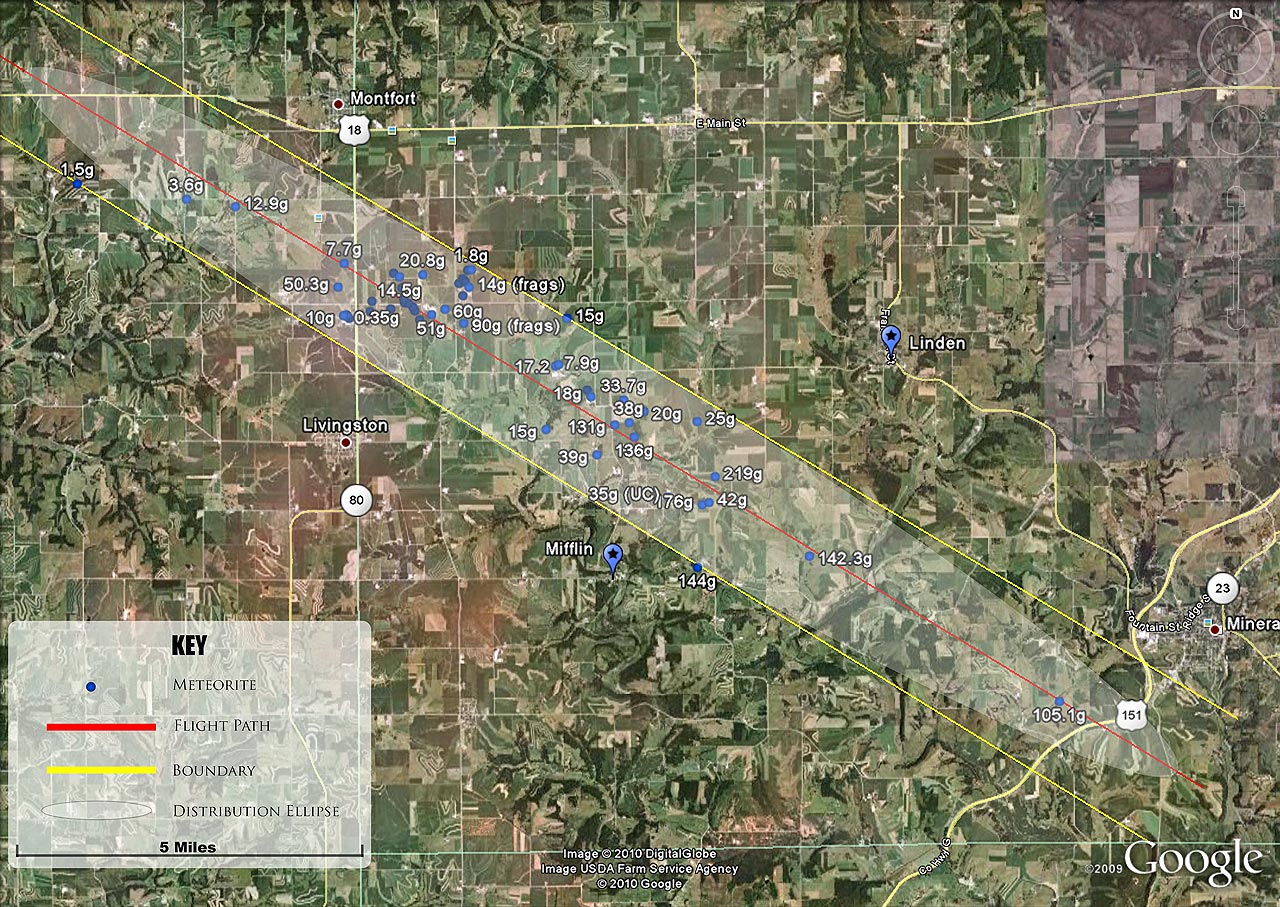
Radar Overlay Map – Download Larger JPG Map 8.12MB
Here is one radar overlay for comparing find locations to actual Radar returns. Notice most returns are South and West of find locations.

Google Earth KMZ File of the Wisconsin Meteorite Strewnfield – Download KMZ
For those of you interested in the actual GE file, here it is. You will need Google Earth installed on your computer to view the KMZ file format. Click Here To Download Google Earth
Thanks & Appreciation
Thanks go out (in no certain order) to Mike Miller, Ruben Garcia, Mike Farmer, Rob Matson, Rob Wesel, Sonny Clary, Steve Arnold of Meteorite Men, Robert Woolard, Mark Hirsch, Vicky Olds, Greg Hupe, Michael Cottingham, Derek Bowers, Larry Atkins, Jim Baxter, Kieth & Dana Jenkerson, Shea Gorzelanczyk. If I missed someone PLEASE forgive me, let me know and I’ll add you to the list.
Most of all I would like to thank all the kind and generous people of Livingston, WI, and surrounding towns which allowed all of us to hunt for “little black rocks” on their lands. To them all of us owe great thanks and appreciation. I’ve never met nicer people than in WI, even in the Pacific Northwest people aren’t as nice. They chatted with us, allowed us on their lands, invited us into their home and informed us of the history and folklore of the area. We learned much about the rich culture and history of the hard working people. I for one can say I’m truly thankful for their generosity. Thank you Wisconsin!
Special thanks go out to the folks at the “Friendly Place” on Hwy 80 in Livingston. An aptly named establishment, which became the hub of the area for the likes of us. Can’t forget the “squeaky cheese”! So yummy! Oh and to the folks at the “Popcorn Shop” in Montfort, I couldn’t eat another bite I stuffed myself with so much of your GREAT popcorn. So many flavors to choose from I had to get them all.
Finding A Meteorite:
The feeling of sheer shock and excitement when you look down and “see” a meteorite laying on the ground before you is indescribable. But I’ll try… Your heart jumps, you pause, seconds tick by and realize you’re holding your breath hoping it doesn’t disappear. After all you’ve been hunting for so long. You finally breathe, and warily kneel before your celestial prize, your mind focused intently, your heart racing, and your body rushing and filling with emotion and the primal instinct to snatch it up and hold it high in the air and scream at the top of your lungs “GOT ONE!” to your hunting partner, who’s probably to far away to hear you anyway. You regain your composure enough to calm yourself and reach for your camera, shoot an in-situ photo of your glorious meteorite and GPS the find location. You look up and realize your hunting partner is standing beside you, attracted most likely by your insanely crazy display of happiness. You share a few back pats, and the customary handshake, congratulations and then it’s off to find another. Possibly days, weeks, or months of hunting away.
Mifflin Meteorite Photos in Situ
